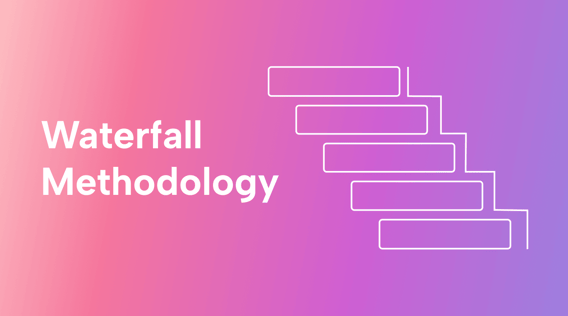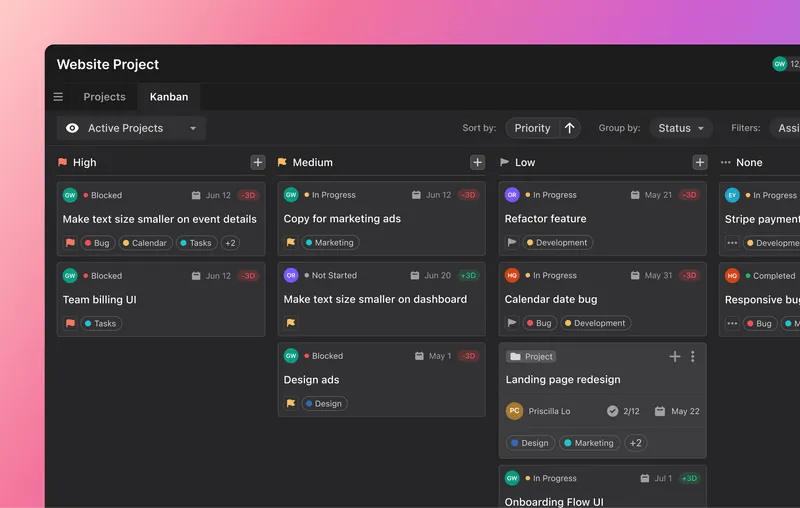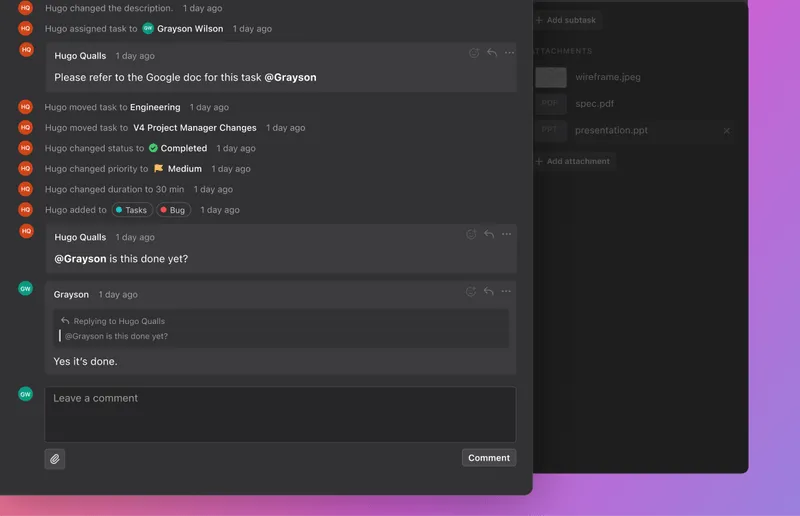Are you ready to unlock the secrets of effective project management?
In a world where chaos reigns supreme, the waterfall approach stands tall with its structured and sequential nature. It's like following a well-crafted recipe to create a mouthwatering project outcome.
In this article, we'll take a deep dive together into the world of waterfall methodology. We'll explore its six essential phases that lay the foundation for project excellence. By the end, you'll know to achieve efficiency and clarity in your endeavors.
Let's dive right in.
What is the waterfall methodology?
The waterfall methodology is like a clear, well-defined roadmap for project execution. It progresses step by step, ensuring each phase is complete before moving on.
Imagine building a mobile application. In the waterfall approach, you'd start by gathering requirements from stakeholders. Then, you'd design the user interface and architecture. You'd follow that up with development, testing, and deployment. Each phase flows logically, building upon the previous one.
The waterfall method brings stability, predictability, and a sense of order to projects.
The phases of the approach create an understanding of project requirements. This sets a solid foundation for project success and minimizes misaligned deliverables.
In larger projects, the stage-gate process acts as a strategic checkpoint. It calls for thorough evaluation and approval before progressing with the respective phases.
It's important to note that detailed documentation is a key aspect of this method. Capturing every phase and outcome provides insights for future projects.
6 phases of the waterfall methodology
The waterfall method consists of six distinct phases. Each phase builds upon the completion of the previous one, a lot like a cascading waterfall.
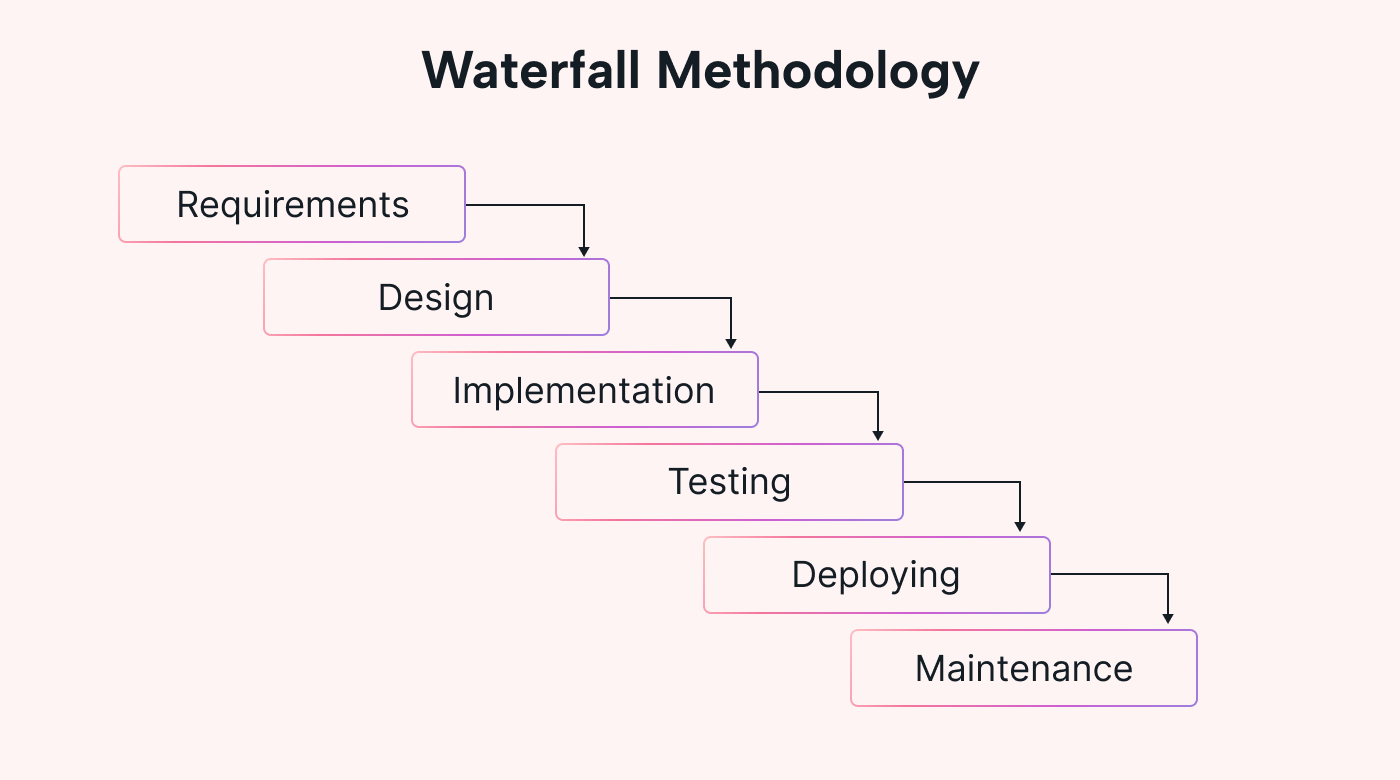 |
Here are the 6 phases of the waterfall method:
Phase 1: Requirements gathering
As with most methods, you must first define the project scope and objectives. This is so that you can have a clear understanding of what the goals are. With the waterfall process, you need to make the scope as defined as possible before moving on. This will act as a strict guideline for the final outcome.
Conduct stakeholder interviews early, as they shape the project's scope. You should then document and validate the information to use it for the project.
Phase 2: Design
With a clear understanding of the requirements, the project enters the design phase (planning phase).
Here, you create a detailed project roadmap. You consider timelines, resource allocation, and deliverables. You break the project down into smaller, manageable components. Likewise, you prepare documents to capture the project's timelines, resource allocation, and deliverables.
Then take them to get signed by the stakeholders so that you can continue.
Phase 3: Implementation
After successful approval, the project moves into the implementation phase. Project managers need to assign tasks and use their teams to bring the project to life.
Use the plan and design stages to monitor the timeline, deliverables, and resource allocation. This helps keep everything within scope throughout this phase.
Phase 4: Testing
Testing is necessary to uphold quality and reliability. You can carry out test procedures at various levels, including:
- Unit testing
- Integration testing
- And system testing
If you identify and address issues, you guarantee a robust and reliable end product.
In this phase, you’ll also compare the requirements you've gathered with the product.
At the end of this phase, you should showcase the product to stakeholders to see if it meets their expectations. Once signed off, you can go ahead with deploying.
Phase 5: Deploying
With a tested project in hand, it's time for deployment. The final project goes into production and is made available for actual use. In this phase, the focus shifts toward the successful release of the project.
Phase 6: Maintenance
After completing the previous phase, the maintenance phase begins. This is where continuous monitoring and support are vital. Any change requests or enhancements that arise should be taken care of promptly. This phase ensures the project remains optimized and aligned with evolving needs.
An example of the 6 phases of waterfall methodology in action
To illustrate the waterfall in action, let’s use a hypothetical example.
Let's consider an example of a new e-commerce business. And let’s say they want the project team to develop a site for a clothing brand.
Phase 1: Requirements gathering
In the initial phase, the project team interviews stakeholders. They bring in the brand managers and the marketing team during this interview. These interactions aim to gather and document the precise prerequisites for the website.
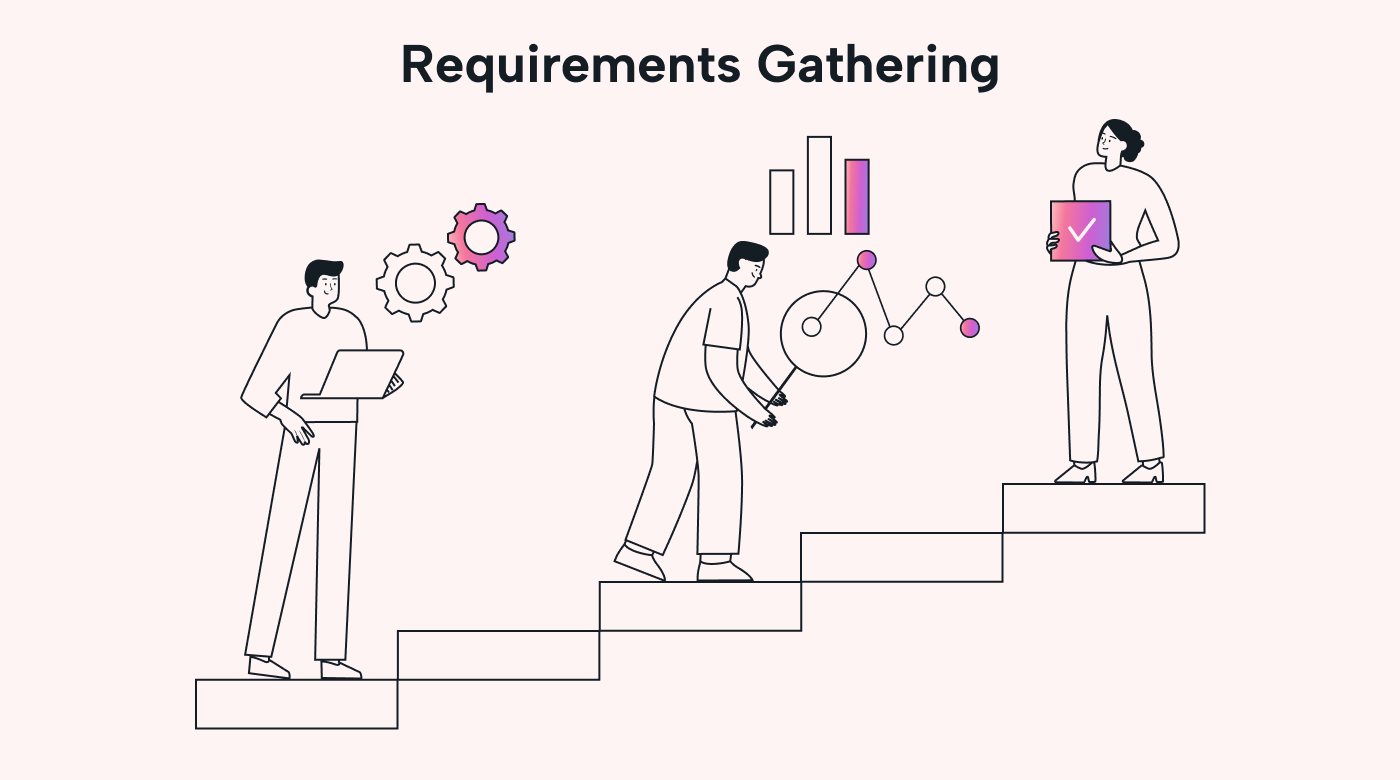 |
Through in-depth conversations, they capture the brand's vision and identify the target audience. They pinpoint needs such as a product catalog, smooth shopping experience, and security.
This gathering of requirements guarantees that the next phases align with the brand's goals and objectives. It also lays a solid foundation for the successful deployment of the project.
Top tip: Get everyone involved and flesh it out. This helps gather more information and build team morale and accountability.
Phase 2: Design
After gathering the requirements, the team transitions into the design phase. This is where they create an interface that prioritizes user experience. They craft an intuitive and visually appealing design for the e-commerce website. They also plan the site's structure, navigation, and prominent design elements.
Once they finalize the design, it undergoes a crucial step – stakeholder approval. This is to check that it aligns with their brand identity and objectives.
Phase 3: Implementation
With the approved design, the team transforms it into functional components and features. They assign tasks to the development team using a systematic approach.
Throughout the implementation process, the team adheres to the design specifications. They maintain consistency and quality and create a product that strives to meet the goals and objectives.
As development continues, regular updates among team members help address challenges. This also helps them maintain a smooth workflow.
Thanks to careful planning, they turn the key concepts into tangible elements of the e-commerce website.
Phase 4: Testing
The testing phase plays a vital role in the functionality and quality of the e-commerce website. The team conducts extensive testing at different levels and measures those against the goals. Any defects or issues discovered during testing should be taken care of.
All this makes sure that it meets the highest standards of quality, reliability, and performance.
Once the team is confident with the site, they approach the client to showcase it and get it signed off.
Phase 5: Deploying
After completing the testing phase, it's time to deploy the finalized website. Once deployed, the website is accessible to the public, where users can now browse and make purchases.
Phase 6: Maintenance
With the website live and operational, the project enters the maintenance phase. The project team provides ongoing support to address any issues or bugs that may arise. They monitor the website's stability, security, and optimal performance.
They also work with stakeholders to handle change requests and enhancements.
Benefits of the waterfall methodology
This structured and sequential approach has tons of benefits. The table below summarizes some surface-level benefits before we discuss a few more important ones deeper.
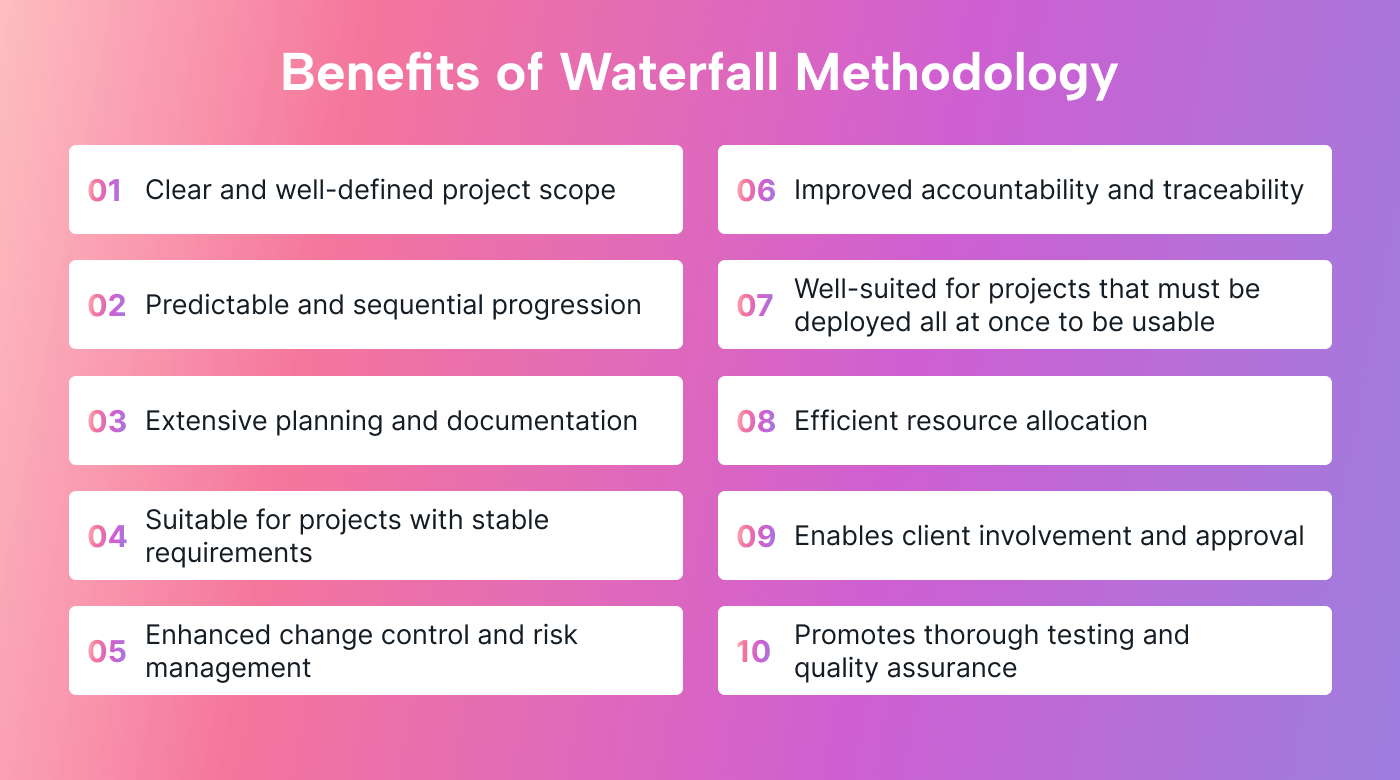 |
One of the standout benefits is the clarity and predictability of project timelines. This allows you to plan better, allocate resources, and deliver on time.
Besides timeline clarity, it brings the power of clear project milestones. Each phase represents a significant accomplishment, marking the completion of specific deliverables. These milestones serve as checkpoints for your project to stay on track. They also help you assess progress by comparing them to the goals.
Another useful benefit is the focus on a well-defined project scope. Taking the time to assess the boundaries and objectives upfront gives better scope clarity.
It's beneficial for projects with stable requirements, which call for enhanced control, risk management, and accountability.
Waterfall or Agile?
Waterfall and Agile are two of the most popular methodologies in project management. One requires clear-cut goals and planning, and the other requires flexibility and adaptability.
The waterfall methodology is known for its sequential and structured nature. It works well when project requirements are well-defined and stable. Imagine building a rocket destined for the moon or developing software for an airplane. Those have to work all at once. These scenarios require a meticulous approach where a clear understanding of the end goal is paramount. Waterfall provides a systematic progression for thorough planning and execution. This promotes a sense of order and stability.
On the other hand, the Agile method embraces flexibility, collaboration, and iterative development. It thrives in dynamic environments where requirements may evolve or need further exploration. The Agile approach is ideal when delivering a minimal usable product that can iterate and improve based on additional features and feedback. This approach fosters adaptability, promotes customer satisfaction, and encourages teamwork.
Choosing between waterfall and Agile depends on the nature of your project. If you require a comprehensive and well-understood solution, waterfall is the way to go. Agile is a better fit if your project involves continuous feedback or evolving requirements.
The decision should align with your project's specific needs and objectives. Think about the project scope, complexity, stakeholder involvement, and the ability to make changes.
When to use the waterfall methodology
The waterfall approach suits projects with stable requirements and a well-defined scope.
It's beneficial when there's a need for limited-scope changes throughout the project lifecycle.
Another consideration is the need for limited scope changes during the project lifecycle. Unlike Agile methodologies, where flexibility and adaptability matter. Waterfall projects have a fixed scope that is less prone to frequent changes. This is beneficial when stakeholders require a stable outcome.
The waterfall methodology is used in the following industries:
- Construction: due to their complex nature and the need for meticulous planning and coordination. The linear approach allows for careful sequencing of activities. So that each phase is done before moving on to the next.
- Engineering: projects often require detailed design, rigorous testing, and adherence to specifications. The waterfall methodology provides a systematic framework for managing these projects.
- Infrastructure development: such as building roads, bridges, or airports, use the waterfall method. These projects involve numerous stakeholders, extensive planning, and a clear understanding of project milestones.
- Manufacturing: projects that include developing new products or processes use waterfall. The structured nature of the waterfall allows for a systematic progression for software development projects. Making sure that each step is validated before moving forward.
Choose the best methodology for your organization
While the waterfall methodology offers clarity, predictability, and comprehensive documentation, it may not suit every project. Many companies utilize a combination of methods, based on the nature of their products or services. This can apply if you have a project that requires clear upfront planning but Agile development. Or you may have some projects that fall in each camp.
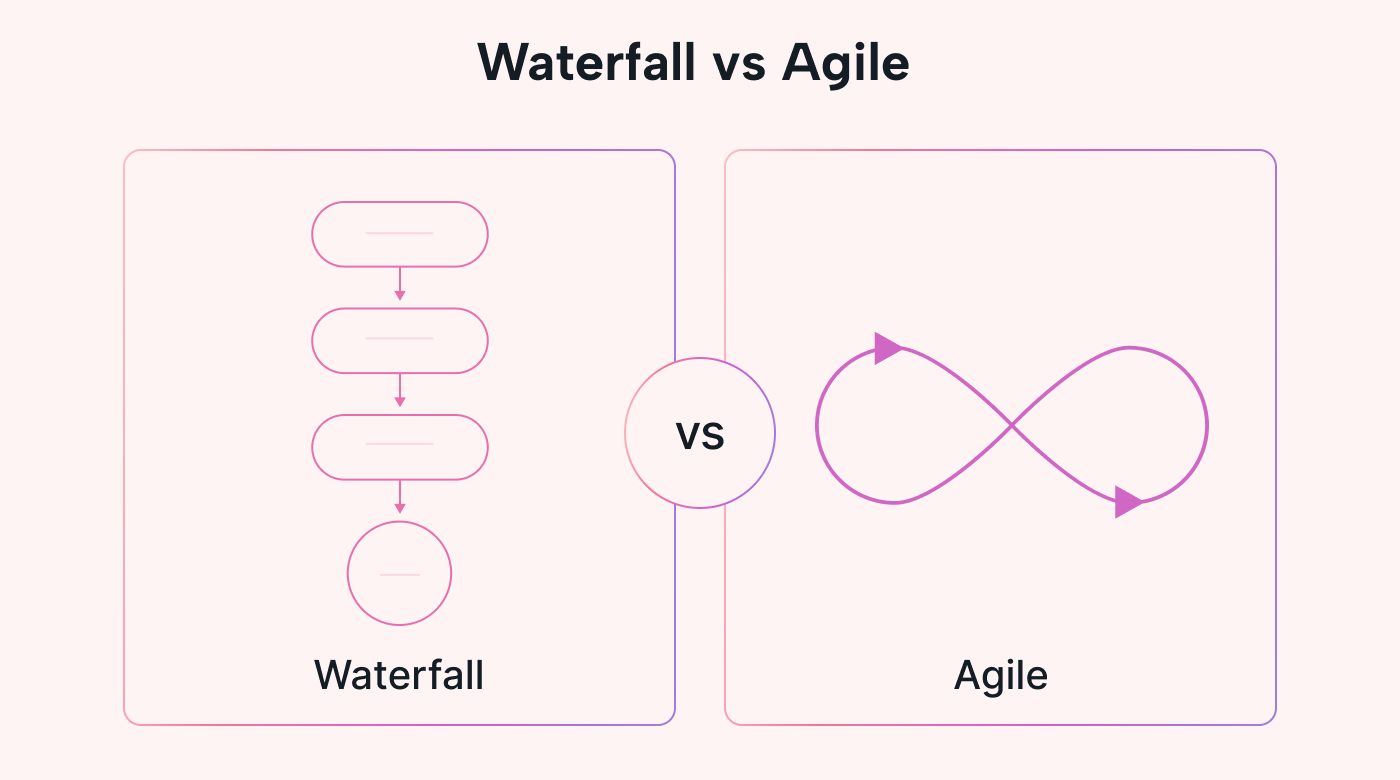 |
Consider project characteristics and benefits of using the waterfall methodology discussed earlier. Look at factors like project complexity, stability, and level of client involvement to determine if it is the right choice.
You can use project management solutions like Motion to implement various methods. With Motion, managing projects becomes easier, thanks to its intuitive AI and support for any project management method.
Motion: the all-in-one project management solution
Motion is the ultimate solution designed to simplify project management. As mentioned, it facilitates the waterfall model and supports various Agile frameworks. With Motion, you gain access to a robust feature set that caters to the unique needs of project teams.
The platform offers a flexible Kanban board for visual project tracking. Making it easier for teams to organize tasks, track progress, and optimize workflows. This applies to a sequential waterfall approach or an iterative approach. Motion provides the necessary tools and customization options to adapt to your requirements.
Streamline communication with Motion's built-in chat, file sharing, and real-time updates.
The task management and prioritization capabilities can allocate resources for you. It can manage dependencies and stay on top of deadlines so that you can focus on your work.
Motion is a comprehensive project management solution regardless of project size or complexity.

